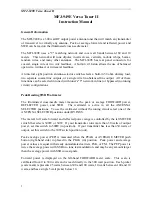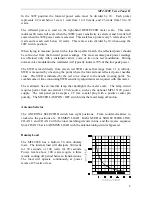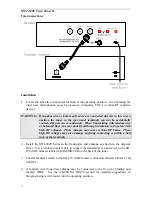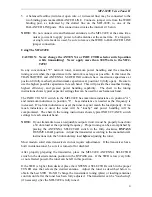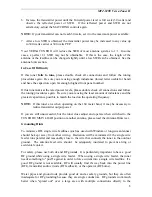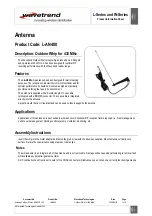
MFJ-949E Versa Tuner II
6
6. Increase the transmitter power until the Forward power level is full scale (30 watts) and
observe the reflected power or SWR. If the reflected power and SWR are not
satisfactory, adjust the MATCHING controls again.
NOTE:
If your transmitter can not reach 30 watts, set it to the maximum power available.
7. After a low SWR is obtained, the transmitter power may be increased to any value up
to 300 watts carrier or 300 watts PEP.
Your VERSA TUNER II will reduce the SWR of most antenna systems to 1:1. In some
cases, a perfect 1:1 SWR may not be obtainable. If this is the case, the length of the
antenna or the feedline can be changed slightly until a low SWR can be obtained. See the
antenna hints section.
In Case Of Difficulty
If this tuner
fails to tune,
please double check all connections and follow the tuning
procedures again. Be sure you are using enough inductance (lowest letter usable for band)
and have the capacitors open far enough (highest front panel number).
If this tuner
arcs
at the rated power levels, please double check all connections and follow
the tuning procedures again. Be sure you are using the least amount of inductance and the
greatest capacitance possible to match the load on the operating frequency.
NOTE:
If this tuner arcs when operating on the 160 meter band, it may be necessary to
reduce transmitter output power.
If you are still unsuccessful, but the tuner does adjust and operate when switched to the
TUNED DUMMY LOAD position or another antenna, please read the Antenna Hints text.
Grounding Hints
To minimize RFI, single wire feedlines (such as used with Windom or longwire antennas)
should be kept away from other wiring. Radiation will be minimized if the single wire
feeder runs parallel and reasonably close to the wire that connects the tuner to the outdoor
ground. The antenna feed wire should be adequately insulated to prevent arcing or
accidental contact.
For safety, please use both dc and RF grounds. It is particularly important to have a good
RF ground while using a single wire feeder. When using a single wire feeder, the tuner
needs something to "push" against in order to force current into a single wire feedline. If a
good RF ground is not available, RF will usually find it's way back into the power line
(RFI), transmitter audio circuits (RF feedback), or the operator (RF burns).
Water pipes and ground rods provide good dc and ac safety grounds, but they are often
inadequate for RF grounding because they are single conductors. RF grounds work much
better when "spread out" over a large area with multiple connections directly to the


